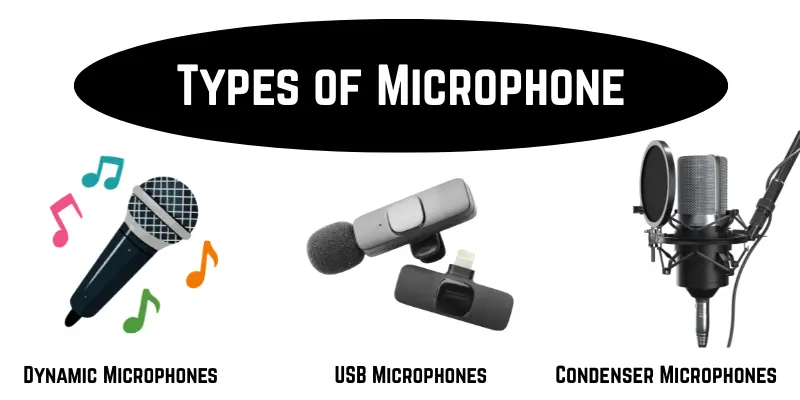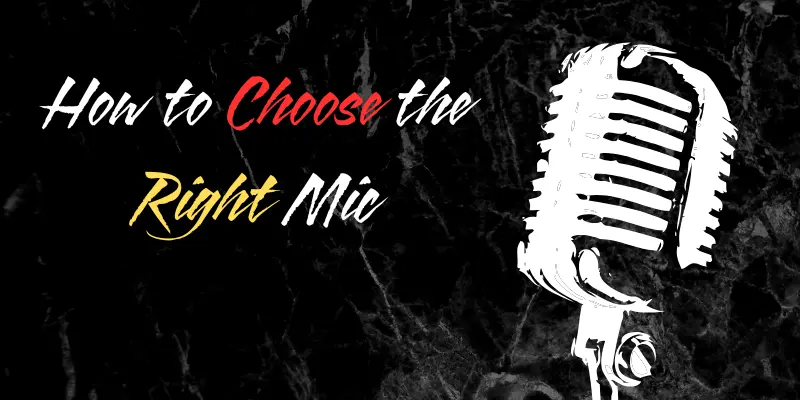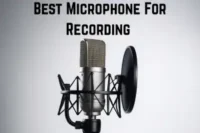Best Microphone for Recording: Your Complete Guide for Clear, Crisp Audio
Published: October 1, 2025
A good microphone may greatly enhance the quality of your recordings. Whether you’re recording a podcast, singing a song, creating a YouTube video, or recording your guitar playing, the right microphone will make your voice or instrument sound clear and professional.
There are so many types of microphones out there that it can be confusing. Should you use a USB microphone or an XLR mic? A dynamic or condenser microphone? Don’t worry, we’ll make things simple for you.
In this guide, we will help you choose the best microphone for your needs. We’ll explain the various types of microphones, share the best microphone for recording options for every budget, and show you how to set up your mic for the best sound.
Ready to find the best microphone for recording and make your recordings shine? Let’s get started!
Mic Types Overview
Before you pick the top Microphones for Recording, it’s important to know the main types of microphones. Each type has its style and sound. Let’s break them down simply.

1. Dynamic Microphones
Dynamic microphones are durable and can withstand loud noises without breaking. They’re ideal for live performances, drums, and guitar amplifiers. These microphones don’t pick up much background noise, making them an excellent choice for recording in a noisy room.
2. Condenser Microphones
Condenser microphones are more sensitive and capture more details. They’re ideal for studio recordings, vocals, and acoustic instruments. These microphones require a power source (phantom power), which is typically provided by an audio interface or mixer.
3. USB Microphones
USB microphones are extremely easy to use. They can be plugged directly into your computer without the need for additional hardware. They’re ideal for beginners, podcasters, and YouTubers who want a simple setup and high-quality sound.
4. Ribbon Microphones
Ribbon microphones are special and give a warm, vintage sound. They are mostly used in professional studios for vocals or instruments, such as the electric guitar. They are delicate and require careful handling.
5. Lavalier and Shotgun Microphones
Lavalier mics (small clip-on microphones) and shotgun mics are commonly used in video and film production. Lavalier microphones are ideal for interviews and vlogs, whereas shotgun mics focus on sound from a single direction, reducing background noise.

How to Choose the Right Mic
Choosing the best microphone for recording can feel tricky, but don’t worry! You just need to think about how you will use it. Let’s make it simple.
1. What Will You Record?
- Voice-over or Podcast
Go for a condenser or USB microphone. These mics pick up your voice clearly and make it sound warm and natural. - Singing and Music Vocals
A condenser microphone is the best choice. It captures more details in your voice and makes it sound rich. - Instruments
Use dynamic mics for loud instruments like drums or electric guitar amps. For acoustic guitar or piano, a condenser mic works better because it catches more detail. - Videos and Vlogs
USB microphones or shotgun mics are great for YouTube or streaming. Lavalier mics (clip-on mics) are also good for talking on camera.
2. What Is Your Budget?
- Under $100
You can find good USB microphones that are easy to use and sound clear. - $100 to $300
You can get better condenser or dynamic mics with more features and higher sound quality. - Above $300
Professional microphones with excellent clarity, perfect for studio-quality recordings.
3. Where Will You Record?
- Quiet Studio or Room
You can use sensitive condenser microphones to capture every detail. - Noisy or Untreated Room
A dynamic microphone is better since it ignores most background noise.
Top Picks by Use-Case
Now that you know what to look for, let’s take a look at some of the best microphones for recording in various situations. These recommendations cover every budget and need, allowing you to find the ideal match.
1. Voice-Over & Podcast
- Budget Pick: Fifine K669B: A simple USB microphone that sounds clear and works great for beginners.
- Mid-Range: Blue Yeti: Popular for podcasts and streaming, simple to set up, and with a variety of pickup patterns.
- Pro Choice: Shure SM7B: A popular choice among professional podcasters and radio hosts. It produces a warm, smooth sound while effectively blocking out background noise.
2. Singing & Music Vocals
- Budget Pick Audio-Technica AT2020: A great condenser mic for beginners who want studio-quality sound without spending a lot.
- Mid-Range Rode NT1-A: It was appreciated for its clear and detailed sound. It also includes a shock mount and pop filter.
- Pro Choice Neumann TLM 102: A top choice for serious singers and studios. It captures every detail of your voice beautifully.
3. Instruments
- Budget Pick Shure SM57: A classic dynamic mic that works well on guitar amps, drums, and even some vocals.
- Mid-Range AKG P420: A versatile condenser mic that can handle many instruments, from acoustic guitars to pianos.
- Pro Choice AKG C414 XLII: Used in top studios worldwide, perfect for all instruments thanks to its multiple pickup patterns.
4. Video & Vlogging
- Budget Pick Rode VideoMicro: A small shotgun mic that mounts on your camera and improves sound quality fast.
- Mid-Range Rode NT-USB: Easy to use, great for voice-overs, streaming, and talking videos.
- Pro Choice Sennheiser MKE 600: A professional shotgun mic that focuses on your voice and cuts out background noise.
Mic Setup & Recording Tips
Even if you have the best microphone for recording, you must set it up correctly to get the best results. Here are some simple steps to help you record like a pro.
1. Mic Placement
- Keep the microphone 6 to 12 inches away from your mouth or instrument.
- To get a clear and strong signal, point the microphone directly at the sound source.
- Try not to move around too much while recording so that your sound is even.
2. Use a Pop Filter
A pop filter reduces “p” and “b” sounds, which can make a recording sound harsh. It also prevents spit from hitting the microphone. Place it a few inches in front of the microphone.
3. Control Background Noise
- Record in a quiet room.
- Turn off fans, air conditioners, and other noisy devices.
- Put soft items like blankets or foam panels around the room to stop echoes.
4. Check Your Levels
- Before you begin, check your volume levels.
- Your sound should not be too loud (causing distortion) or too soft (making it difficult to hear).
- Aim for levels that remain in the green or yellow zones on your recording meter.
5. Stay Comfortable
- Use a stand or arm to support your microphone so you don’t have to bend or hold it.
- Sit or stand in a relaxed position to make your voice sound more natural.
Quick Comparison Table
| Microphone | Type | Best For | Key Feature |
| Fifine K669B | USB | Podcasts, voice-over | Easy plug-and-play setup |
| Blue Yeti | USB | Podcasts, streaming | Multiple pickup patterns |
| Shure SM7B | Dynamic | Pro voice-over, vocals | Smooth sound, great noise control |
| Audio-Technica AT2020 | Condenser | Singing, vocals | Clear studio-like sound |
| Rode NT1-A | Condenser | Singing, vocals | Very low noise, detailed sound |
| Neumann TLM 102 | Condenser | Studio vocals | Premium, crystal-clear detail |
| Shure SM57 | Dynamic | Instruments, amps | Durable and versatile |
| AKG P420 | Condenser | Instruments, guitars | Multi-pattern versatility |
| AKG C414 XLII | Condenser | Pro instruments | Multiple patterns, pro-level |
| Rode VideoMicro | Shotgun | Vlogging, cameras | Small, easy to use on cameras |
| Rode NT-USB | USB | Voice-over, video | Clear sound, simple USB setup |
| Sennheiser MKE 600 | Shotgun | Pro video, film | Focused audio reduces noise |
Conclusion
Selecting the best microphone for recording does not have to be difficult. It’s much easier to find the right microphone once you know what you’re looking for, whether it’s for podcasts, singing, instruments, or videos.
Remember that each microphone has unique strengths and limitations, so it’s helpful to understand the pros and cons of microphones. Consider your space, your budget, and the sound you want. Also, take the time to properly set up your microphone for the best results.
A good microphone can help your voice or instrument sound more professional and clear. Now that you’ve learned about your options, you can begin producing high-quality recordings.
Frequently Asked Questions (FAQs)
Here are some common questions people ask about the best microphones for recording, along with clear and helpful answers.
A condenser microphone is typically the best option for vocals. It captures more detail while making your voice sound clear and warm. Popular choices include the Audio-Technica AT2020 and the Rode NT1-A.
Yes! Many USB microphones sound great and are very easy to use. They are perfect for podcasts, streaming, and home recordings. But for studio-level quality, an XLR mic is usually better.
A dynamic mic is strong and great for loud sounds or noisy places. A condenser mic is more sensitive and works well in quiet rooms. It picks up more detail, which is good for vocals and instruments.
Record in a quiet room, turn off fans or other noisy devices, and use a pop filter. You can also use a dynamic mic since it picks up less background noise.
If you opt for an XLR microphone, you’ll need an audio interface to connect it to your computer. USB microphones do not require an interface; they can be plugged in directly.

- Be Respectful
- Stay Relevant
- Stay Positive
- True Feedback
- Encourage Discussion
- Avoid Spamming
- No Fake News
- Don't Copy-Paste
- No Personal Attacks

- Be Respectful
- Stay Relevant
- Stay Positive
- True Feedback
- Encourage Discussion
- Avoid Spamming
- No Fake News
- Don't Copy-Paste
- No Personal Attacks





